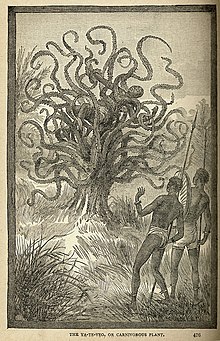Cryptobotania

Cryptobotania est studium variarum plantarum mirificarum quae a communitate scientifica non esse creduntur, sed in mythis, litteris, et relationibus incertis tractantur. Fabulae vulgares ethnicusque plantarum usus saepe ut investigatio interdisciplinaria evolvuntur et offeruntur pro speciebus ignotis, auctoribis sperantibus has species collectas esse vel melius agnosci. Aliquis scriptor vel investigator se cryptobotanista appellare potest; disciplina intra periodica cryptozoologica inspicitur et sustentur, sed per variantis scepticismi gradus ut protoscientia.[1]
Multae plantae revera non iam inventae vel descriptae sunt; usitate autem attingit cryptobotania plantas vanas, coniunctiones noxias vel salutares cum hominibus habere putatas. Fontes datorum secundarii vel exigui esse possunt; famae aut verisimiles aut absurdae esse possunt.[2]
Plantae quae homines edunt (vide illustrationem), saepissime in fictione populari inventae densasque Africae silvas habitantes, in famis conduntur plantarum quae mammalia capere et interficere possunt, sicut Nepenthes rajah.[3] Sunt autem famae non confirmatae, plerumque ex America Australi, quae arguunt species plantarum carnivorosarum non iam inventas esse, secundum librum The Beasts That Hide From Man Caroli Shuker, cryptozoologi Britannici.[4]
Nexus interni
Notae[recensere | fontem recensere]
- ↑ Ben S. Roech, Taking a Hard Look at Cryptozoology: A Critical Approach to Cryptozoology (Author's On-Line Cryptozoology Archives, 1999). "Thus the argument goes: in order to ensure accuracy in cryptozoology, research on sasquatch should be done by a primatologist or physical anthropologist, and research on sea serpents should be done by a marine biologist, preferably one who has good knowledge of both invertebrate and vertebrate marine organisms."
- ↑ Paul McCarthy (1993), "Cryptozoologists: An Endangered Species," The Scientist 7(1): "Krantz is a member of a small band of scientists called cryptozoologists, who stalk previously undescribed—and, some would say, nonexistent—animals. This includes new species of lizards, monkeys, and other ho-hum creatures, but also beasts of mythic proportion."
- ↑ A. Phillipps (1988), "A second record of rats as prey in Nepenthes rajah," Carnivorous Plant Newsletter 17(2):55.
- ↑ Karl P. N. Shuker, The Beasts That Hide From Man (Paraview, 2003, ISBN 1-931044-64-3).
Bibliographia[recensere | fontem recensere]
- McKenna, Terence. 1992. Food of the Gods: The Search for the Original Tree of Knowledge: A Radical History of Plants, Drugs, and Human Evolution. Bantam. ISBN 0-553-37130-4.
